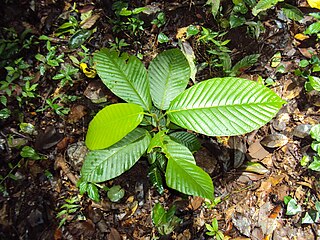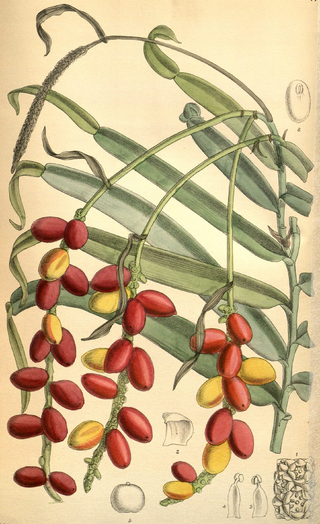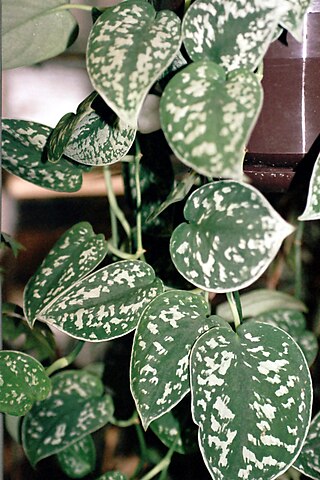
Cryptocoryne is a genus of aquatic plants from the family Araceae. The genus is naturally distributed in tropical regions of India, Southeast Asia and New Guinea. The English common name "water trumpet" refers to their inflorescence, a spadix enclosed by a spathe, which resembles a trumpet. The genus is commonly referred to as to as Crypts by aquarium hobbyists.

Antidesma is a genus of tropical plant in the family Phyllanthaceae formally described by Linnaeus in 1753. It is native to tropical Africa, S + E + SE Asia, Australia, and various oceanic islands. The greatest diversity occurs in Southeast Asia.

Mallotus is a genus of the spurge family Euphorbiaceae first described as a genus in 1790. Two species are found in tropical Africa and Madagascar, while all others are found in East Asia, the Indian Subcontinent, Southeast Asia, eastern Australia, and certain islands of the western Pacific. The genus has about 150 species of dioecious trees or shrubs.

Trigonostemon is a plant genus of the family Euphorbiaceae and the sole member of its tribe (Trigonostemoneae). It was first described as a genus in 1826. It is native to Southeast Asia, southern China, the Indian Subcontinent, Queensland, and a few islands in the western Pacific.
Wetria is a plant genus of the family Euphorbiaceae, first described as a genus in 1858. It is native to Australia, New Guinea and Southeast Asia.
- Wetria australiensisP.I.Forst. - Papua New Guinea, Queensland
- Wetria insignis(Steud.) Airy Shaw - Thailand, Myanmar, Peninsular Malaysia, Borneo, Sumatra, Java, Lesser Sunda Islands, Philippines

Tritaxis is a genus of plants under the family Euphorbiaceae first described as a genus in 1858. It is native to Southeast Asia, including parts of India, Sri Lanka, China Hainan, else into Philippines New Guinea, and Northern Australia (Queensland). Until recently, many species were listed under the genus Dimorphocalyx, first described as a genus several years later in 1861.

Aporosa is a genus of flowering plant belonging to the family Phyllanthaceae, first described as a genus in 1825. It is native to China, the Indian Subcontinent, Southeast Asia, Papuasia, and Queensland.

Cleistanthus is a plant genus of the family Phyllanthaceae, tribe Bridelieae, first described as a genus in 1848. It is widespread in much of the Old World Tropics in Asia, Africa, Australia, and various oceanic islands. Cleistanthus collinus is known for being toxic and may be the agent of homicides or suicides.

Drypetes is a plant genus of the family Putranjivaceae, in the order Malpighiales.

Kayea is a plant genus in the family Calophyllaceae. Its species range from Bangladesh and the eastern Himalayas to Sri Lanka, Indochina, Peninsular Malaysia, Borneo, Sumatra, the Philippines, New Guinea, and Queensland.

Dipterocarpus is a genus of flowering plants and the type genus of family Dipterocarpaceae.

Daphniphyllum is the sole genus in the flowering plant family Daphniphyllaceae and was described as a genus in 1826. The genus includes evergreen shrubs and trees mainly native to east and southeast Asia, but also found in the Indian Subcontinent and New Guinea.

Chionanthus, common name: fringetrees, is a genus of about 140 species of flowering plants in the family Oleaceae.

Actinodaphne is an Asian genus of flowering plants in the laurel family (Lauraceae). It contains approximately 125 species of dioecious evergreen trees and shrubs.

Pothos is a genus of flowering plants in the family Araceae. It is native to China, the Indian Subcontinent, Australia, New Guinea, Southeast Asia, and various islands of the Pacific and Indian Oceans.

Barringtonia is a genus of flowering plants in the family Lecythidaceae first described as a genus with this name in 1775. It is native to Africa, southern Asia, Australia, and various islands of the Pacific and Indian Oceans. The genus name commemorates Daines Barrington.

Alseodaphne is a genus of plants in the family Lauraceae, endemic to China and Southeast Asia. The genus has 96 species of evergreen trees to shrubs. They have bisexual flowers, a fruit stalk that is red, green, or yellow, and black fruit.

Scindapsus is a genus of flowering plants in the family Araceae. It is native to Southeast Asia, New Guinea, Queensland, and a few western Pacific islands. The species Scindapsus pictus is common in cultivation.

Sciaphila is a genus of mycoheterotrophic plants in the family Triuridaceae. These plants receive nutrition from fungi and neighboring trees and have less need for photosynthesis. It is widespread in tropical and subtropical regions, found in Africa, China, Japan, the Indian Subcontinent, Southeast Asia, Latin America and on various islands Pacific Islands. The most noteworthy feature of the genus is the number of the various flower parts 99.9 percent of Monocots are trimerous, but Sciaphila spp. can have eight or even ten parts in a whorl.

Phrynium is a genus of flowering plants native to China, India, Southeast Asia, New Guinea and Melanesia. It was described as a genus in 1797.



















